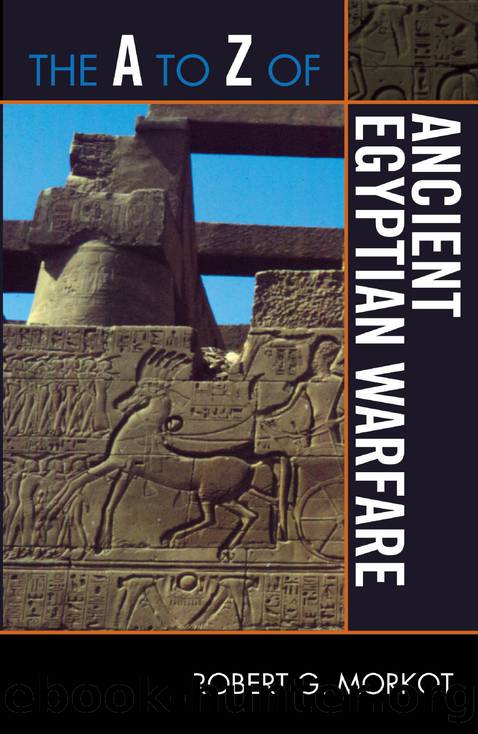The A to Z of Ancient Egyptian Warfare by Morkot Robert

Author:Morkot, Robert. [Morkot, Robert.]
Language: eng
Format: epub
ISBN: 9781461671701
Publisher: Scarecrow Press
Published: 2003-09-15T05:00:00+00:00
â M â
MACE. One of the earliest weapons of war and symbols of the pharaohâs might. Numerous maceheads in different shapes and unusual stones survive from the earliest periods. The ceremonial macehead of king âScorpionâ attests the significance of the object, and it is the weapon favored in all early images of the king smiting his enemies (e.g., the Narmer Palette; Label of Den). In the New Kingdom, the mace is frequently (but not always, see e.g., the pylon reliefs at Medinet Habu) replaced in such scenes by the khepesh, although it remains an essential royal attribute.
MACHIMOI. According to Herodotos (II 164), the Egyptians were divided into seven classes, of which the military (the machimoi) and priests ranked highest. The military class was divided (by place of origin) into the Kalasirians, who numbered, at their most numerous, 250,000 men and Hermotybians, at most 160,000. They were forbidden to follow any other trade or craft, had an exclusively military education and training, and were hereditary in the male line. This warrior-class had certain privileges, and only the priestly class had similar. Each man was granted 12 arouras of land, free of tax. A thousand from each group served as the kingâs bodyguard, with grants of food. This description of a military caste does not fit the evidence from the New Kingdom, although it has influenced interpretation of the evidence. However, the term recurs in papyri from Ptolemaic Egypt and it has been assumed that Herodotosâs account reflects a Late Period development that continued into the Ptolemaic period. The evidence actually seems to be far less clear. Although some writers have taken Ptolemaic references to machimoi to refer to the Greek standing army, the evidence from the papyri was argued by both Jean Lesquier, and by Bernard Grenfell and Arthur Hunt, to mean the native Egyptian military caste. It has been argued further that, following the battle of Raphia, these Egyptian machimoi were settled as cleruchs, receiving grants of land, notably in Fayum villages, such as Kerkeosiris.
MADJOY. The name originally indicated an ethnic group from Nubia. Identification with the modern Beja of the Eastern Desert has been suggested, on a similarity of names. From the Middle Kingdom onward, it refers to an official group of quasi-military nature in Egypt, and apparently mostly of Egyptian origin, who are generally described as âpoliceâ in the literature. They are depicted in the tomb reliefs at Amarna. The small numbers of Madjoy who appear in texts, and some of their associations, suggest that they were some type of specialized force. A small number was attached to the protection of the royal necropolis at Thebes and resided on the west bank. The Madjoy might also have had a role as frontier guards, in the fortress of Senmut and the Wadi Tumilat. Fifty Madjoy took part in the quarrying expedition of Ramesses IV to the Wadi Hammamat. The office of âChief of the Madjoyâ in the later New Kingdom was one of the high offices of state. Men holding the title are often found overseeing building works in which numbers of troops are employed.
Download
This site does not store any files on its server. We only index and link to content provided by other sites. Please contact the content providers to delete copyright contents if any and email us, we'll remove relevant links or contents immediately.
The Daily Stoic by Holiday Ryan & Hanselman Stephen(3264)
The Fate of Rome: Climate, Disease, and the End of an Empire (The Princeton History of the Ancient World) by Kyle Harper(3033)
People of the Earth: An Introduction to World Prehistory by Dr. Brian Fagan & Nadia Durrani(2711)
Ancient Worlds by Michael Scott(2650)
Babylon's Ark by Lawrence Anthony(2649)
The Daily Stoic by Ryan Holiday & Stephen Hanselman(2527)
Foreign Devils on the Silk Road: The Search for the Lost Treasures of Central Asia by Peter Hopkirk(2442)
India's Ancient Past by R.S. Sharma(2432)
MOSES THE EGYPTIAN by Jan Assmann(2395)
The Complete Dead Sea Scrolls in English (7th Edition) (Penguin Classics) by Geza Vermes(2258)
Lost Technologies of Ancient Egypt by Christopher Dunn(2208)
The Earth Chronicles Handbook by Zecharia Sitchin(2204)
24 Hours in Ancient Rome by Philip Matyszak(2065)
Alexander the Great by Philip Freeman(2045)
Aztec by Gary Jennings(1993)
The Nine Waves of Creation by Carl Johan Calleman(1898)
Curse Tablets and Binding Spells from the Ancient World by Gager John G.;(1852)
Before Atlantis by Frank Joseph(1832)
Earthmare: The Lost Book of Wars by Cergat(1806)
